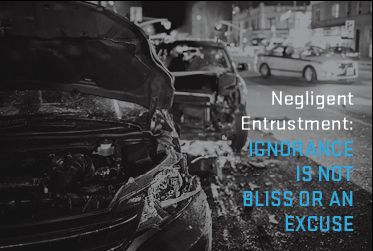
Picture this scenario: It’s nearing the end of the work day and it has been a productive, but uneventful day — thank goodness — and you’re almost ready to head home for a well-earned evening of relaxation. Just as you’re getting ready to walk out the door, you get a phone call. One of your drivers rear-ended another vehicle on his way back to the office.
Aside from the damage done to the front of his vehicle and the back of the other car’s, the vehicle he hit was occupied by a family with several small children in the backseat. Thankfully, no one suffered any serious injuries. Still, you can’t help but think of the headache that lies ahead.
As you put the fleet accident protocol into play — and prepare to brief your superiors — many questions will start to run through your mind.
How fast was he driving when he rear-ended the vehicle? Was he driving distracted/using his cell phone? When was the last time his driving record was checked? Is his license valid or suspended? Has he had any other incidents in the past? How about any incidents in the past year? When was the last time he went through any sort of driver training? Is his vehicle in good condition? When was the last time his vehicle was checked for maintenance? In short, what was the driver’s risk profile?
DRIVER BEHAVIOR IS THE BIGGEST SOURCE OF FLEET LIABILITY
Be prepared. Not knowing what violations are on a driver’s license may be deemed negligent entrustment, which is the act of entrusting an automobile with a driver who the owner (in this case the fleet) knows could use the vehicle to cause harm to others based on previous behavior. Negligent entrustment and other associated vehicle safety lawsuits have become a common concern and worry for fleet managers. Companies have an ongoing obligation to track drivers’ licenses if they continue providing a vehicle and putting them on the road with other motorists.
Any company that has drivers is at risk for these types of lawsuits. The question is, how well prepared are you to defend yourself and your company in the event one should occur?
If litigation occurs as a result of an employee driving a company vehicle, the plaintiff’s attorney will ask to review your written fleet policy guidelines and how well it was enforced. Prior exceptions to fleet policy, if discovered (and it most certainly will), will likely render the fleet and its company vulnerable to negligent entrustment or negligent retention allegations.
DEFENDING AGAINST NEGLIGENT ENTRUSTMENT
A proactive approach, working in advance to improve fleet safety rather than reacting after the fact to incidents, will go hand-in-hand to positively impact a company’s risk profile and bottom line in the long run.
Employers should know who they’re entrusting their valuable and costly assets with. Most states impose liability when an employer knew or should have known that an employee was unfit to drive a vehicle or that a vehicle was unsafe. This means that companies must be able to show that they did everything they reasonably could to prevent accidents; otherwise actions you did or didn’t take might be construed as negligent entrustment.
STEPS TO COVER YOUR BASES:
1. Background check: During the hiring process, companies should conduct a comprehensive background check on every potential hire, including his or her motor vehicle record (MVR). This is the first step in helping you build a case that you proactively monitored the fleet’s drivers.
2. Training: Once hired, all drivers should receive on-going training, particularly if they’ve been identified as having an elevated risk profile. Along with continued driver safety awareness, providing a comprehensive classroom and behind-the-wheel training program at the time of new-hire training is an effective way to stress that safety is an important corporate value. On-going training is important to demonstrate that a company took care to ensure its drivers were qualified and remain up-to-date on new policies, rules, technologies, etc.
3. Fleet Safety Program: In many ways, defending against negligent entrustment is about establishing procedures and processes that are enforced to ensure a safety work environment. When an employee driver is involved in an accident and a plaintiff’s attorney comes knocking, you need to be able to produce documentation of any inappropriate actions that were due to the driver, and proof that you did whatever you could to address the incident and improve the driver’s risk profile.
4. Continuous MVR Monitoring: An annual MVR doesn’t cut it these days when constant, continuous MVR monitoring is available at a low cost, and has been proven to effectively alert fleet managers about any driving violations in a timely manner. Compare the cost of $15 per driver per year to all the costs associated with a vehicle accident, and in a worst-case scenario, a liability lawsuit, which could run into the millions and seriously damage the company’s reputation.
While continuous MVR monitoring isn’t the only step fleets should take to eliminate risk — it’s the cornerstone of a proactive fleet safety policy, and one of the best precautions that a company can take to prepare in advance for potentially defending themselves in a liability lawsuit.
Continuous MVR monitoring is the foundation of establishing the safety culture, and shows that your company acts proactively to any MVR violation. Download the whitepaper “Liability: Why ‘Good Enough’ Isn’t Good Enough” to learn more about liability, negligent entrustment and continuous MVR monitoring.
Visit eSuperVision.com to download the white paper
The post Negligent Entrustment: Ignorance Is Not Bliss or an Excuse appeared first on Fleet Management Weekly.
from Fleet Management Weekly http://bit.ly/2GJ1zxD



Sourced by Quik DMV - CADMV fleet registration services. Renew your registration online in only 10 minutes. No DMV visits, no lines, no phone mazes, and no appointments needed. Visit Quik, Click, Pay & Print your registration from home or any local print shop.

No comments:
Post a Comment